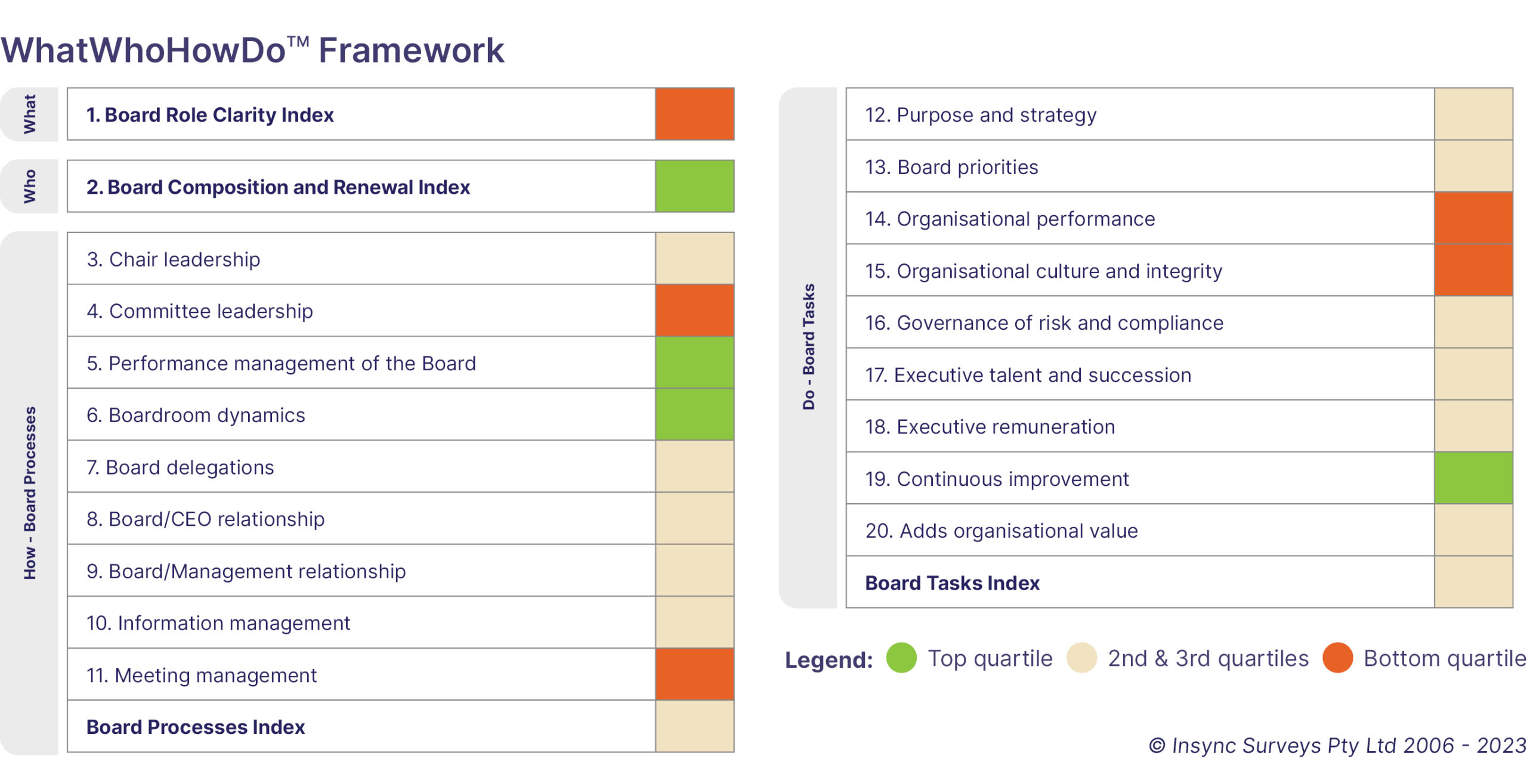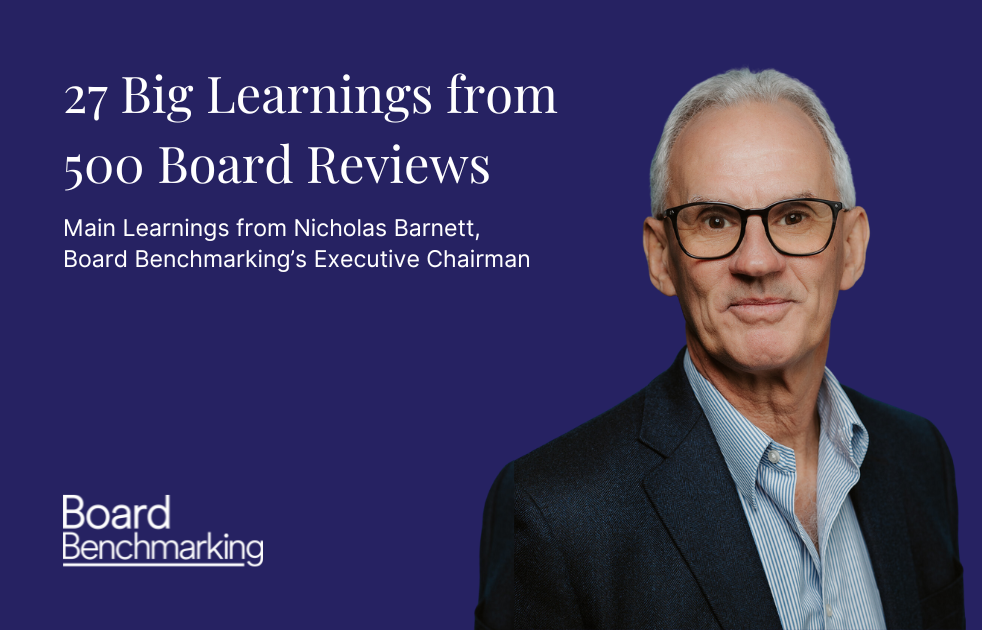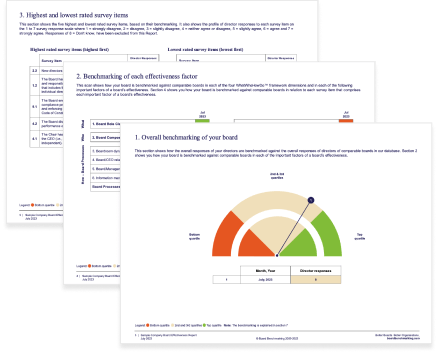Our 27 big learnings from our first 500
1. Boards are much more complicated than we think
Our biggest learning of the last 15-plus years is that boards are much more complicated than most people think. Our research has shown that there are 20 discrete dimensions of a board’s effectiveness – not five, not 10 or 14 but 20! That’s a lot of things to get right – and each one is important. Getting any one or two of them badly wrong can be devastating for a board and consequently an organisation.
When we show people those 20 discrete dimensions, they look at each and agree that they wouldn’t want to exclude any of them from the consideration of a board’s effectiveness. They also say they can’t think of any other areas of effectiveness to add to the list. But it took us nearly 15 years and the help of Deakin University to work out what we all now see as the bleeding obvious. Here is our framework of those 20 discrete dimensions of a board’s effectiveness.

2. Research that shows the effective functioning of a board is a very important contributor to an organisation’s success. Also, a significant number of corporate failures and scandals have been attributed to board mismanagement, conflicts and ineffectiveness. We hope you don’t need to be convinced that Better Boards means Better Organisations.
3. Appropriate benchmarking means comparing your board’s responses with the survey response of similar boards for that same survey item. It is equally important not to benchmark boards of large-listed organisations against small not-for-profit or government organisations or visa versa. That’s why appropriate benchmarking against comparable boards makes all the difference.
Our other learnings are structured under the WhatWhoHowDo framework set out above.
What – Board role clarity
4. Many directors don’t fully understand their role and how it differs from the executive team. Some aren’t sufficiently strategic and dig too deeply into operational issues. Some others think they are there to police the executive. This needs to be managed well by the Chair with the help of the CEO.
Who – Board composition and renewal
5. Board diversity and renewal are important foundation stones for a high-performing board. Many boards could improve in one or both of these areas.
6. We should all know by now that diversity is critical to high performance. What is less known is that it takes much longer to build relationships, trust and rapport with those directors who are quite different from us – and not enough boards invest the time and effort required to build those strong and robust relationships.
7. Many boards still don’t have enough directors with the appropriate skills and experience in the core business of the organisation. This compromises the board’s ability to govern rigorously and add value.
How – Board processes (or what we also often call the hygiene)
8. If the board, and each director, were more proactive in supporting and developing their Chair, the board and organisation would benefit. If the board has an ineffective Chair, it is better for everyone if the Chair is replaced. That is often easier said than done, but it is important.
9. Committees are often too siloed, and their work is often not sufficiently aligned with and connected to the organisation’s priorities.
10. Poor director behaviour, commitment or performance too often goes unchecked by the Chair and others. This undermines the board’s effectiveness and its working relationship with management.
11. Robust relationships and dynamics are essential for a high-performing and resilient board. At least 25% of boards have dysfunctional relationships within the board, with their CEO and/or executive team. Not enough effort is made to understand and then deal with the dysfunction.
12. The board’s time is precious so use it wisely. Calibrate the meeting at the start to ensure extra focus on the most important issues. Limit presentations from management and maximise discussion time.
13. Most boards would benefit from being less reactive and learn to sit with the frustration and tension of the unknown and not knowing. This provides a space for new learnings, innovation and ‘out of the box’ thinking to emerge.
14. Not enough boards run a sufficiently differentiated board agenda, and instead just go through the motions doing the same old thing.
15. Many boards could have more regular and more effective in-camera sessions without the CEO or management in attendance. Many could also spend more time just with the board and CEO, including informally.
16. Many boards could spend more time just with the board and CEO, including informally. Dinners prior to a board meeting are a good time to do this.
17. Boards should set a high bar for their own performance and effectiveness. This helps set the high tone from the top which is so important.
18. Many boards could improve how they manage the overall performance of the CEO. Ideally, all directors are engaged at the front end of the process and updated after the process has been completed.
19. Many boards and executives could work better together to improve the format, relevance, insightfulness and forward-looking nature of board papers. This helps the development of executives and the oversight of the board.
Do – Board tasks
20. Most boards don’t think deeply enough about the legacy they want to leave, the difference they can/will make and the value they will add.
21. Boards are likely to add more value if they become aligned around a smaller number of priorities and pivot their focus and efforts accordingly. Too many differing priorities erode the focus and efforts of the board, the executive team and the organisation.
22. Most boards don’t involve themselves early enough in the development of strategy, with too many simply waiting for the strategy to be presented for approval by the CEO. Boards should engage earlier in discussions about the big strategic questions with management and provide appropriate strategic guidance.
23. A greater focus is still required by many boards on organisation culture and integrity. This includes the oversight of a more strategic approach to stakeholder management.
24. Governance of risk management and compliance is taken seriously by most boards, but many could be better at understanding and overseeing the management of emerging risks, including IT and cyber risk.
25. Many boards could do more to encourage a strong culture of organisational performance, including ensuring appropriate action is taken when performance measures are not met.
26. Most boards could take a more active role and a longer-term approach to their oversight of executive talent development and succession planning.
27. Boards that have performed poorly and been ineffective in the past can significantly improve their performance and effectiveness within, say, twelve months. Almost always a catalyst for change is required. A clear benchmarked Board Effectiveness Report is often that catalyst.
If you would like to receive our regular research and insights please Subscribe to our newsletter.



